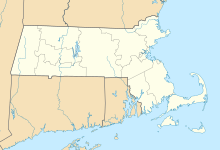
The American Antiquarian Society (AAS), located in Worcester, Massachusetts, is both a learned society and national research library of pre-twentieth century American history and culture. Founded in 1812, it is the oldest historical society in the United States with a national focus. Its main building, known as Antiquarian Hall, is a U.S. National Historic Landmark in recognition of this legacy. The mission of the AAS is to collect, preserve and make available for study all printed records of what is now known as the United States of America. This includes materials from the first European settlement through the year 1876.

The Hancock–Clarke House is a historic house in Lexington, Massachusetts, that is a National Historic Landmark. Built in 1738, the house is notable as the only surviving house associated with statesman John Hancock, who lived here for several years as a child. It played a prominent role in the Battle of Lexington and Concord as both Hancock and Samuel Adams, leaders of the colonials, were staying in the house before the battle. The House is operated as a museum by the Lexington Historical Society. It is open weekends starting in mid-April and daily from May 30–October 31. An admission fee is charged.

Adams National Historical Park, formerly Adams National Historic Site, in Quincy, Massachusetts, preserves the home of United States presidents John Adams and John Quincy Adams, of U.S. envoy to Great Britain Charles Francis Adams, and of writers and historians Henry Adams and Brooks Adams.

The John Adams Birthplace is a historic house at 133 Franklin Street in Quincy, Massachusetts. It is the saltbox home in which the second president of the United States, John Adams, was born in 1735. The house was designated a National Historic Landmark in 1960, and is listed on the National Register of Historic Places. It is now administered by the National Park Service as part of the Adams National Historical Park, and is open for guided tours.

The John Quincy Adams Birthplace is a historic house at 141 Franklin Street in Quincy, Massachusetts. It is the saltbox home in which the sixth United States President, John Quincy Adams, was born in 1767. The family lived in this home during the time John Adams helped found the United States with his work on the Declaration of Independence and the American Revolutionary War. His own birthplace is only 75 feet (23 m) away, on the same property.
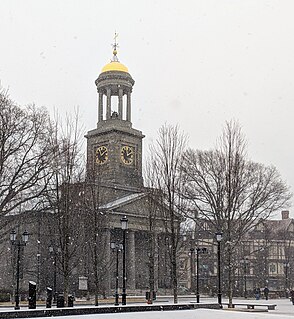
United First Parish Church is a Unitarian Universalist congregation in Quincy, Massachusetts, established as the parish church of Quincy in 1639. The current building was constructed in 1828 by noted Boston stonecutter Abner Joy to designs by Alexander Parris. The building was designated a National Historic Landmark on December 30, 1970, for its association with the Adams family, who funded its construction and whose most significant members are interred here.

The Thomas Crane Public Library (TCPL) is a city library in Quincy, Massachusetts. It is noted for its architecture. It was funded by the Crane family as a memorial to Thomas Crane, a wealthy stone contractor who got his start in the Quincy quarries. The Thomas Crane Library has the second largest municipal collection in Massachusetts after the Boston Public Library.

Quincy Senior High School is the regional public high school for Quincy, Illinois. It is the largest high school in Adams County, Illinois, and the only high school in Quincy Public School District 172.

The Massachusetts Historical Society is a major historical archive specializing in early American, Massachusetts, and New England history. It is located at 1154 Boylston Street in Boston, Massachusetts, and is the oldest historical society in the United States, having been established in 1791.

The John Wood Mansion was built between 1835 and 1838 by John Wood, who in 1860 became the 12th governor of Illinois on the death of Governor William Bissell. The Wood family moved into the Greek Revival home situated at 12th and State Streets in Quincy, Illinois from an unusual two-story log cabin in 1837. Quincy is the county seat of Adams County. Wood founded both the county (1825) and city (1835).

The Andrew John Volstead House is the historic house in Granite Falls, Minnesota, of ten-term United States Congressman Andrew Volstead (1860–1947). It is now managed as a museum and the organizational headquarters of the Granite Falls Historical Society. Volstead became nationally synonymous with Prohibition in 1919 when, as chairman of the House Judiciary Committee, he was obliged to author the Volstead Act, enabling enforcement of the recently ratified Eighteenth Amendment. Volstead was a moderate progressive who coauthored the Capper–Volstead Act in 1922, which legalized agricultural cooperatives.

Adams Academy was a school that opened in 1872 in Quincy, Massachusetts, United States. John Adams, the second President of the United States, had many years before established the Adams Temple and School Fund. This fund gave 160 acres (0.65 km2) of land to the people of Quincy in trust. His objective for the money was to build a school in honor of his friends John Hancock and Josiah Quincy, who, like Adams, lived in the town of Quincy, Massachusetts. John Hancock's birth place had been on the land.

The Hill–Physick–Keith House, also known as the Hill–Keith–Physick House, the Hill–Physick House, or simply the Physick House, is a historic house museum located at 321 S. 4th Street in the Society Hill neighborhood of Philadelphia, Pennsylvania, USA. Built 1786, it was the home of Philip Syng Physick (1768–1837), who has been called "the father of American surgery". The house was declared a National Historic Landmark in 1976. It is now owned and operated by the Philadelphia Society for the Preservation of Landmarks as a house museum.

The John Brown House is the first mansion built in Providence, Rhode Island, located at 52 Power Street on College Hill where it borders the campus of Brown University. The house is named after the original owner, one of the early benefactors of the University, merchant, statesman, and slave trader John Brown. It was declared a National Historic Landmark in 1968. John Quincy Adams considered it "the most magnificent and elegant private mansion that I have ever seen on this continent."

The William Trent House is a historic building located at 15 Market Street in Trenton, Mercer County, New Jersey. It was built in 1719 for William Trent and is the oldest building in Trenton. He founded the eponymous town, which became the capital of New Jersey. It has served as the residence for three Governors. The house was added to the National Register of Historic Places and listed as a National Historic Landmark on April 15, 1970, for its significance as an example of Early Georgian Colonial architecture.

The Dorothy Quincy Homestead is a US National Historic Landmark at 34 Butler Road in Quincy, Massachusetts. The house was originally built by Edmund Quincy II in 1686 who had an extensive property upon which there were multiple buildings. Today, the site consists of the Dorothy Quincy Homestead, which has been preserved as a museum and is open occasionally to the public.
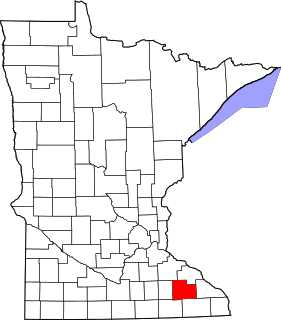
This is a list of the National Register of Historic Places listings in Olmsted County, Minnesota. It is intended to be a complete list of the properties and districts on the National Register of Historic Places in Olmsted County, Minnesota, United States. The locations of National Register properties and districts for which the latitude and longitude coordinates are included below, may be seen in an online map.

The Woodward School is a historical, private, secular day school for girls in grades six through twelve. It is located in Quincy, Massachusetts, near Quincy Center, and is the only private high school in the city. On top of its core syllabus, the school offers a wide curriculum which includes Latin, French, Spanish, Visual Arts, Psychology, Rhetoric, Music Theory, to name but a few.
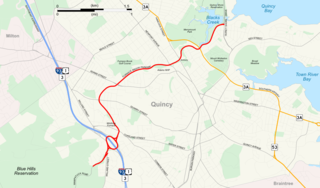
Furnace Brook Parkway is a historic parkway in Quincy, Massachusetts. Part of the Metropolitan Park System of Greater Boston, it serves as a connector between the Blue Hills Reservation and Quincy Shore Reservation at Quincy Bay. First conceived in the late nineteenth century, the state parkway is owned and maintained by the Massachusetts Department of Conservation and Recreation (DCR) and travels through land formerly owned by the families of John Adams and John Quincy Adams, passing several historic sites. It ends in the Merrymount neighborhood, where Quincy was first settled by Europeans in 1625 by Captain Richard Wollaston. The road was started in 1904, completed in 1916 and added to the National Register of Historic Places (NRHP) in 2004.
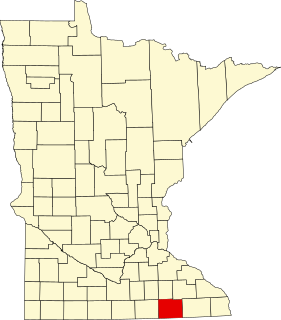
This is a list of the National Register of Historic Places listings in Mower County, Minnesota. It is intended to be a complete list of the properties and districts on the National Register of Historic Places in Mower County, Minnesota, United States. The locations of National Register properties and districts for which the latitude and longitude coordinates are included below, may be seen in an online map.


